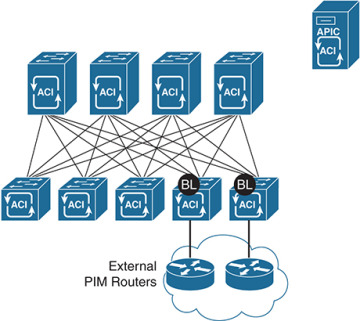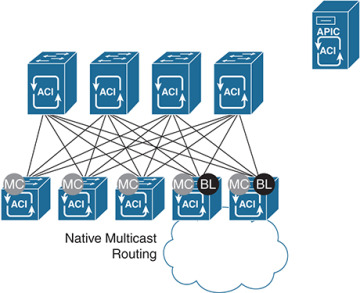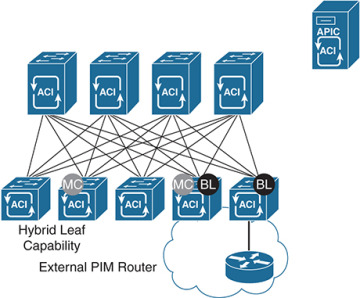Multicast
Many enterprise data center applications require IP multicast support and rely on multicast packet delivery across Layer 3 boundaries to provide necessary services and functions.
Previous versions of the ACI fabric were limited to constraining IPv4 multicast at Layer 2 within each bridge domain based on the Internet Group Management Protocol (IGMP) snooping state. Any inter–bridge domain multicast routing, as well as multicast routing in to or out of the Cisco ACI fabric, requires a Protocol-Independent Multicast (PIM) router external to the fabric to perform those functions.
With the introduction of APIC 2.0(1), along with the Cisco Nexus 9300 EX leaf-switch platforms based on the leaf-and-spine engine (LSE) application-specific integrated circuit (ASIC), the Cisco ACI fabric itself provides distributed Layer 3 IP multicast routing between bridge domains, reducing or eliminating the need for external multicast routers.
The following multicast protocols are now supported with the 2.0(1) release:
PIM any-source multicast (PIM-ASM)
PIM source-specific multicast (PIM-SSM)
Static rendezvous point (RP), Auto-RP, and bootstrap router (BSR) for RP-to-group mapping
Native Layer 3 IP multicast forwarding between bridge domains in the Cisco ACI fabric requires Cisco Nexus 9300 EX platform leaf switches, built with the LSE ASIC. Earlier leaf-switch platforms do not have the hardware capability to perform inter–bridge domain multicast routing and require an external multicast router to perform this function.
Multicast Best-Practice Recommendations
This section describes recommended best practices for three possible Cisco ACI fabric deployment scenarios. The scenarios differ in the capabilities of the leaf-switch platforms (see Figure 6-34):
All leaf switches are first-generation switches that do not use the Cisco Nexus EX platform. They are based on the application leaf engine (ALE) ASICs and require external multicast routers to perform inter–bridge domain and entry and exit multicast routing.
All leaf switches are second-generation Cisco Nexus EX platform switches. They are based on the LSE ASIC and support native inter–bridge domain Layer 3 multicast routing as well as entry and exit multicast routing at the border leaf.
The leaf switches are a hybrid of some Cisco Nexus EX platform leaf switches and some leaf switches that do not use the EX platform.

Figure 6-34 Three Possible Multicast Deployment Scenarios
Scenario 1: Leaf Switches Not Based on Cisco Nexus EX Platform
The best-practice recommendation is integration of external multicast routers with the Cisco ACI fabric to support inter–bridge domain and entry and exit IP multicast routing, as shown in Figure 6-35.

Figure 6-35 Scenario 1: External PIM Router
Scenario 2: Leaf Switches Based on Cisco Nexus EX Platform
For Cisco ACI fabrics in which all leaf switches are based on the EX platform (see Figure 6-36), the best-practice recommendation is to enable native IP multicast routing in the Cisco ACI fabric. This configuration uses the latest technology generation, simplifies the network design, and simplifies IP multicast routing configuration and management. Documentation outlining how to enable multicast in the ACI fabric can be found in “Cisco ACI and Layer 3 Multicast” at Cisco.com (http://tinyurl.com/ACIL3Multi).

Figure 6-36 Scenario 2: Native Layer 3 Multicast
Scenario 3: Hybrid Fabric with Leaf Switches Both Based on and Not Based on Cisco Nexus EX Platform
In a hybrid environment (see Figure 6-37), in which some of the leaf switches are not based on the EX platform and others are based on the EX platform, the best-practice recommendation is to continue to use an external router to perform multicast routing. Although it is technically possible to combine native multicast routing on EX platform leaf switches for some bridge domains with external multicast routing, for other bridge domains, design, configuration, and management become increasingly complex and error-prone.

Figure 6-37 Scenario 3: Hybrid Leaf Capability
Furthermore, when you enable multicast routing in the APIC, you enable it at the tenant VRF level and then, optionally, at the bridge domain level. For example, if you have a tenant VRF instance with multiple bridge domains, you can enable Layer 3 multicast on all those bridge domains or only on a subset. In either case, you must first enable multicast at the VRF level in order to enable multicast routing on one or more bridge domains within that VRF instance (see Figure 6-38).

Figure 6-38 Layer 2 Versus Layer 3 Multicast for Tenant VRF Instances and Bridge Domains
As shown in Figure 6-38, Tenant VRF1 has Layer 3 multicast enabled for the VRF instance and for all the bridge domains in that VRF instance. Leaf switches can route multicast traffic between any of those bridge domains, and border leaf switches can route traffic in to and out of the Cisco ACI fabric for those bridge domains.
Tenant VRF2 has Layer 3 multicast enabled for the VRF instance, but not all the bridge domains have Layer 3 multicast enabled. Leaf switches can route multicast traffic between BD1 and BD2, but not into BD3. BD3 may or may not have Layer 2 multicast enabled (Layer 2 multicast with IGMP snooping in the bridge domain is enabled by default but can be disabled). If it does, IP multicast traffic can be constrained within the bridge domain, but it cannot be routed to other bridge domains or in to and out of the fabric.
Tenant VRF3 does not have Layer 3 multicast enabled, but may have Layer 2 multicast enabled for some or all the bridge domains. The leaf switches perform no inter–bridge domain routing in this case. An external PIM router must provide any inter–bridge domain multicast routing.
Multicast Configuration Overview
In this section we examine the minimum configuration needed to support both PIM-ASM and PIM-SSM.
Minimum Multicast Configuration: PIM-ASM
The minimum configuration for basic Layer 3 PIM-ASM requires you to enable multicast for the VRF instance, add one or more bridge domains on the Interfaces configuration subtab, and define a static rendezvous point address in the Rendezvous Points subtab. The PIM rendezvous point must be located outside the Cisco ACI fabric. Verify that the rendezvous point IP address is reachable from inside the fabric.
The industry best practice for rendezvous point configuration is AnycastRP using Multicast Source Discovery Protocol (MSDP), with static rendezvous point address configuration. The Layer 3 multicast configuration in the Cisco ACI fabric provides support for specifying a static rendezvous point address for PIM-ASM, as well as dynamic options for disseminating rendezvous point information such as BSR and Auto-RP.
Minimum Multicast Configuration: PIM-SSM
The minimum configuration for basic Layer 3 PIM-SSM requires you to enable multicast for the VRF instance, add one or more bridge domains on the Interfaces configuration subtab, and enable IGMPv3 processing on those bridge domains (PIM-SSM does not require a rendezvous point).